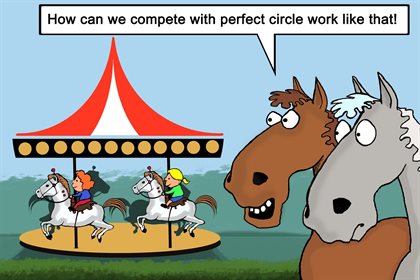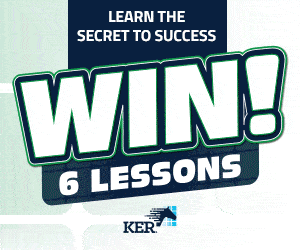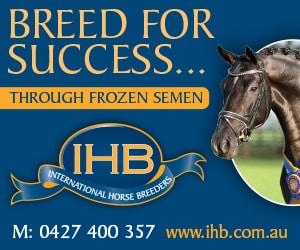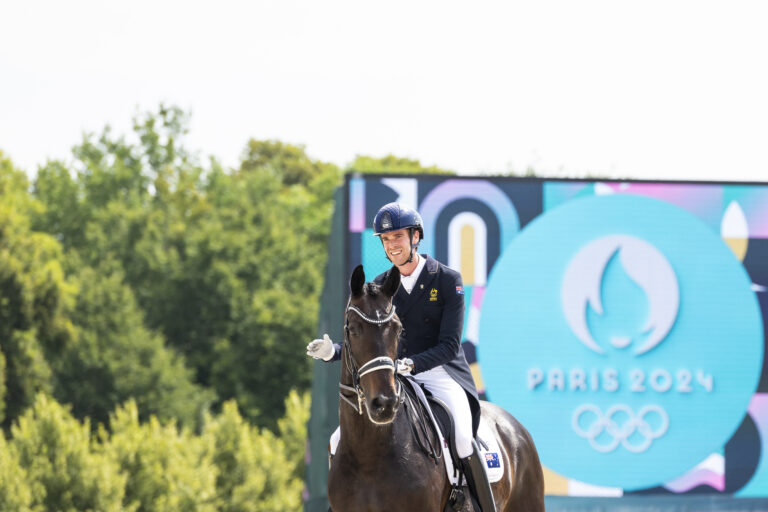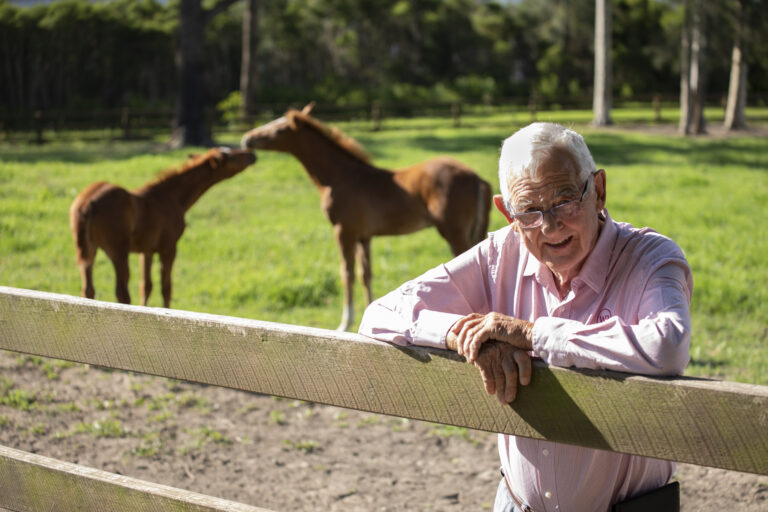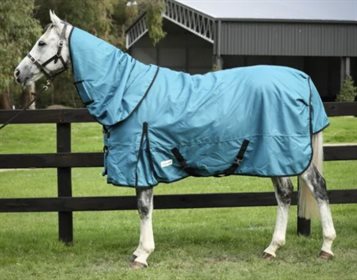Cartoon by Martin Taankink.
The Unfairness of Expecting Perfection in our Horses
By Myra King
“But Myra, you can’t be serious!” my outspoken friend said to me the other day after I shared a video of me riding Tommy bridleless. She wasn’t objecting to me riding with a neck rope, but it was in response to the comment I’d made about Tommy’s nose pointing upwards in a couple of places on the footage.
Before I could answer, she steam-trained on, “You’re riding Tommy without a bridle, jumping, doing circle work in an open paddock. His mate is cavorting nearby like a two year old. There are eight-foot kangaroos hopping all over the place and you go on about Tommy’s nose!”
She’s right, I thought, well not about eight-foot roos (six-foot at most, she’s prone to exaggeration) but the rest of what she’d said was true.
Later, dissecting the video into ‘moments of time’ for photos, I pondered this question: Are we so caught up in getting perfection in our horses that we don’t see the roses for the odd thorn? And to carry the metaphor to its end, maybe it’s those thorns that actually sharpen what’s going right, or wrong? Perhaps we are looking at them from the wrong angle.
Variables matter
When riding and working with horses sometimes we forget there are so many variables that can affect the outcome ie: age, breed/genetics, weather, health, fitness, rider competence, temperament etc.
Closer examination of some of the ‘moments of time’ show my Quarab, Tommy, head up, working from his hinds, not hollow backed at all but well balanced and responsive.
He has a short neck and the Arab propensity, like a Friesian, of a high head carriage. Conversely he can work with his head lower in the quieter paces, walking out body long, neck stretched down naturally, and only holding his head up higher in the trot when nervous or keen.
Encouraging him to relax is something I’ve been working on since I bought him a year ago, doing many miles of walking out, short changes of direction in limited circle work, trying not to ask for too much and always on a forgiving rein.
To understand your own horses’ natural way of moving, watch them at liberty in the paddock when they’re trotting and cantering around, how they hold their heads without interference of rider or bridle.
Tommy’s much more chilled with his leather halter or his neck rope, as he really enjoys having his head free.
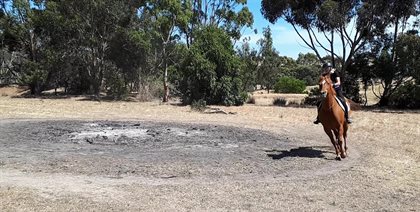
Myra and Tommy.
Stop focusing on what is going wrong
My friend came over again the next day and it was obvious by her narrowing eyes and clefting frown that she clearly wasn’t finished with me. “Myra, horses are like men,” she said, holding up her hand like a policeman stopping traffic, when I started to form a protest. “Men can be wonderful, but always, always there still will be something that’s wrong with them.”
“Us women too,” I said, trying for parity, then shut up. I got her meaning and she was right, too often we focus on what is going wrong with our horses instead of being satisfied or happy with what’s going right.
Some horses hate motorbikes or kangaroos (name the scariest beast of your country – I have another friend who lives in Africa, giraffes are her biggest problem!) or trucks or pushbikes. They may be scared of jumping, or dislike arena work, or freak out and break halters when tied up. Drenching or clipping can be a deep-seated problem for some horses, or they may have a phobia of vets. Some hate trail-riding or get super fizzy at shows, or when hunting.
Of course, most of these problems can be overcome or modified with patient training. Or if not, you have to make up your mind what you are willing, or able, to live with, and what is in your horse’s best interest.
A top dressage rider, who lives locally, had a horse which she found was not settling to arena work, getting progressively more nervous, but this horse loved getting out and about on the roads. So she sold him to a rider wanting to trail ride – perfect match – happy horse and happy rider.
Nature based problems are the hardest
The hardest issues to work with, however, are not behavioural problems at all but are nature-based, such as separation anxiety, or mares being marish, colts being coltish, and breed dispositions.
There are horse owners with no understanding that certain equestrian disciplines sometimes should not be forced onto horses with conformation and temperaments generationally bred for particular jobs, like farm-work, or for certain conditions or terrains e.g.: It is said Arab horses have evolved to hold their heads high so they can see into the far distance when travelling over the sand dunes.
The old adage “horses for courses” is generally true. Warmbloods are often great dressage horses or calm hacks. The heavy horses, like Friesians, work well in carts. Quarter horses are good at the western disciplines. Shetland ponies can be great teachers for kids, especially on how to fall off! Arab horses stand out as the best at endurance.
This does not mean these breeds can’t be used for other equestrian pursuits. But to help them reach their potential, whether that be at competition, or as a safe riding horse, all horses need to be wisely evaluated according to temperament as well as breed and conformation.
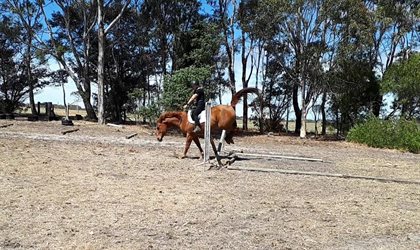
Myra and Tommy jumping.
No rule fits all
Sometimes we forget that ‘training’ rules may not fit all. And we need to question these rules. Who made them in the first place? Are they time-tested? Do they stand up to rational and moral scrutiny? Or are they the ‘Competition Fashion of the Moment,’ to win at all costs, having nothing to do with the comfort and well-being of the horse?
How many horses, with conformation, or temperament, or age unsuited to their owners’ endeavours, are pulled into shape by means of leather, chain and iron, and forced to do what they hate or what breaks them down physically, for the glory of gold?
It’s up to us to choose what is best for our horses and always never to expect perfection. Strive for cooperation and harmony, strive for what you and your horse enjoy the most. What fits its body and mind, and where you can both excel because there is a partnership of mutual understanding.
As my forthright, nearly always right, friend always reminds me, “You’re not perfect, Myra!” And that’s true for us all.
Myra King
“Perfection is the enemy of progress” – Winston Churchill
For over 38 years Myra King has written for equine magazines, including Equestrian Life, R.M. William’s Hoofs and Horns, Rider Magazine, National Rider, The Barefoot Horse UK, The Horse’s Hoof Arizona and a self-help-column in Horse and Pony, Florida. She worked with the outback Brumbies of Australia from the age of 11, starting (breaking) her first colt when she was 14.
Martin Taankink’s cartoons have been widely published. Currently he is the Art Editor for The Heron’s Nest New York.
Myra is the author of two YA horsey novels published by Ginninderra Press:
READ THE LATEST NEWS ARTICLES HERE

